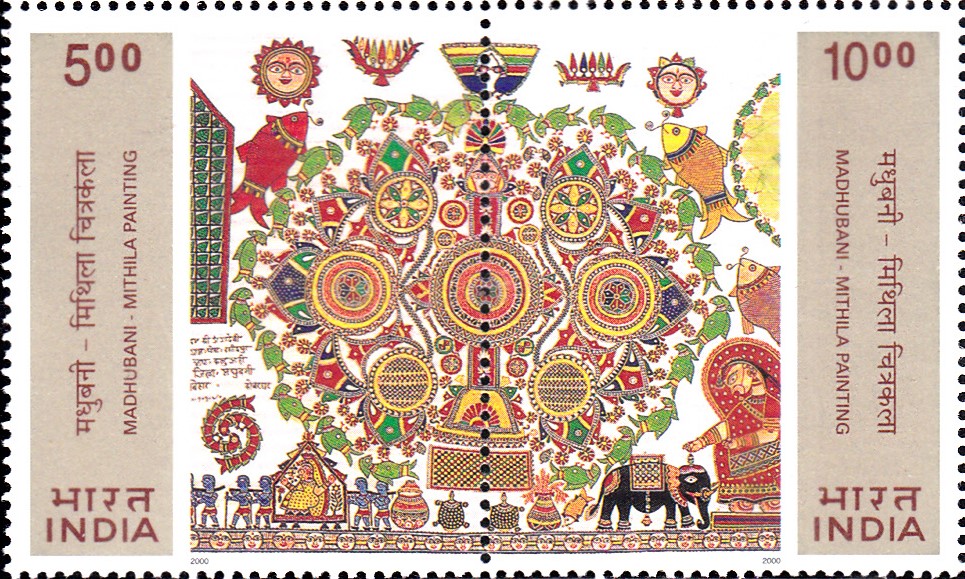
Madhubani – Mithila Painting
Complete Set of 5 nos of postage stamps on the 18th Congress of the Madhubani art, practiced in the Mithila region :
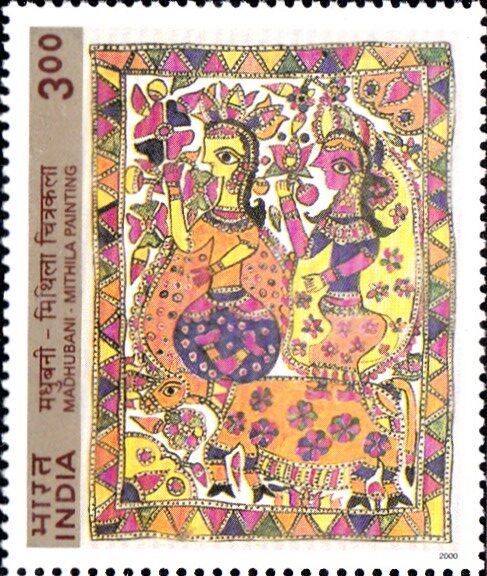
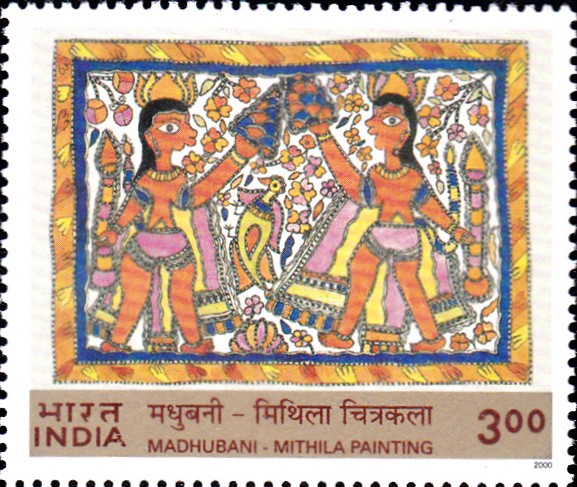
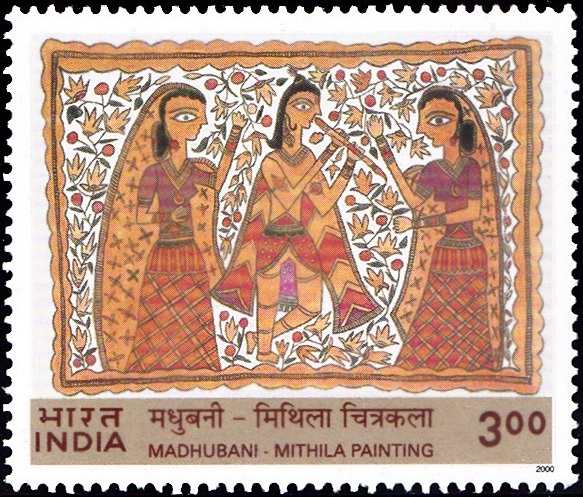

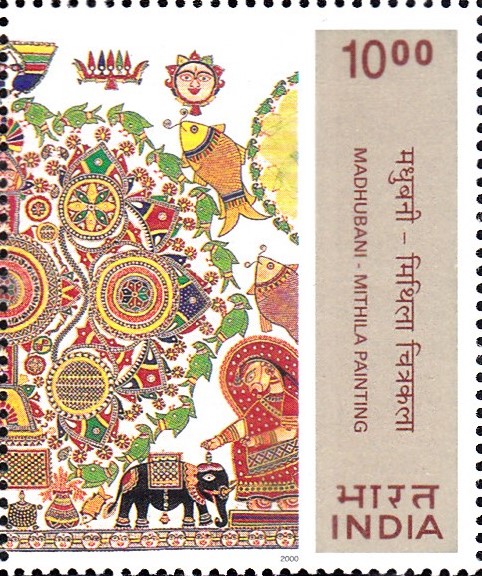
 Issued by India
Issued by India
Issued on Oct 15, 2000
Designs : The designs of the four stamps are based on paintings representing a cross section of the rural social frame-work, incorporating paintings made by women artists from the different strata of the society. They also symbolise the levels of excellence achieved by women in the tradition of Indian folk art. The first and second stamps, depicting the paintings “Flower Girls” by Smt. Nirmala Devi and “Bali and Sugriva” by Smt. Sanjula Devi respectively, possess the extraordinary charm of primordial art reflected in highly stylised and simplified imagery. The third stamp, featuring the painting “Krishna with Gopies” by Smt. Anmana Devi draws upon mythology for its central theme. The fourth stamp shows detail of the central wall of a ‘Kohbar-Ghar’, mural painted by late Smt. Ganga Devi at the ‘Crafts Museum’, New Delhi. It shows the lotus plant motif, a symbol of growth and fertility. Attention is given to minute details such as flower and foliage, ornaments and animals, which brings a certain richness and delicacy to the picture.
The First Day Cover portrays the erstwhile Maharaja of Darbhanga, late Shri Lakshmishwar Singh (1858-1898), patron of arts and letters, who gave encouragement to the evolution of this art form.
Credits :
Stamps : Ganga Devi (Courtesy : Crafts Museum, New Delhi); Anmana Devi, Nirmala Devi and Sanjula Devi (Courtesy : Indian Council for Cultural Relations, New Delhi).
Type : 3 Single Stamps and 1 Se-tenant pair of 2 Stamps, Mint Condition
Colour : Six Colour
Denomination : 300, 300, 300 & (500 + 1000) Paise
Overall size : 4.06 x 4.82 cms.
Printing Size : 3.6 x 4.4 cms.
Perforation : 13.5 x 13.5
Paper : Matt Chromo
Stamps Printed : 3.0 million each
Number per issue sheet : 40
Printing Process : Photo Offset
Printer : Calcutta Security Printers Ltd.
About :
- The district of Madhubani in Bihar forms part of the broader geographical and cultural area called Mithila. Vibrant traditions of ritual paintings have been practised by women in the region since centuries, as a simple means of self-expression. This style of painting is today known alternatively by the names “Madhubani/Mithila Painting”.
- The women of the region conventionally drew geometrical diagrams known as ‘Aripan’ on mud and cow-dung plastered floor, their fingers dipped in rice paste. The nuptial chamber of the bride, was decorated with ritualistic wall paintings, the central wall adorned with an assemblage of symbolic images signifying proliferation of life and growth: lotus plant motif with stylised flowers, the bamboo grove, fishes, birds and other animals. The side wall usually depicted scenes from mythology. A lot of attention was paid to decorating the walls around the shrine of the family deity usually situated in one corner of the kitchen. On the sacred day of the “Durgashtami” both walls flanking the kitchen door were ritually painted with images of Goddess Durga. These paintings center around the calendar of annual ritual events; important sacraments such as birth or weddings.
- The pictorial scheme of symbolic and narrative painting as it traditionally existed was responsible for the later development of narrative painting with large-scale introduction of paper in the 1960s. Individual artists derived much from this composite-narrative tradition and made highly innovative and poetic use of this tradition in their contemporary work. ‘Madhubani’ has emerged as one of best known, among the contemporary styles of folk painting in India.
- Traditionally the women of Madhubani used pigments derived from natural substances: vermilion powder mixed with mustard seed and ground on a mill stone gave a bright red, a mixture of cow-dung and lamp-black combined with goat’s milk produced greenish black, ‘Pevdi’, a mineral, was used for lemon yellow and turmeric for yellow ochre. Indigo and geru, red clay, mixed with gum arabicum or goat’s milk provided blue and Indian red, respectively, as mentioned earlier, rice paste was used for white.
- One of the main directions that Madhubani painting took after the introduction of paper was to create a series of narrative paintings related to mythological stories, drawing on images from ‘Ram Lila’ and ‘Krishna Lila’, folk theatrical performances which were popular in the area. Each community in the village had a certain identifiable style deriving from its commonly shared cultural and stylistic heritage.
- Text : Based on material furnished by Shri Jyotindra Jain, Sr. Director, Crafts Museum, New Delhi.








Nice post and beautiful stamps.
I love to to collect stamps and would be thankful if you could share some information regarding availability of these stamps and where I could purchase these stamps. It appears that they have printed quite a few of these.
[…] with portrayal of beauty and romance. Parrots are also widely illustrated in folk arts such as Madhubani […]
[…] a diasporas through sets of two stamps along with mini-sheet depicting different art forms like Madhubani painting & terracotta, stone & wood carving, metal work, paper machie […]